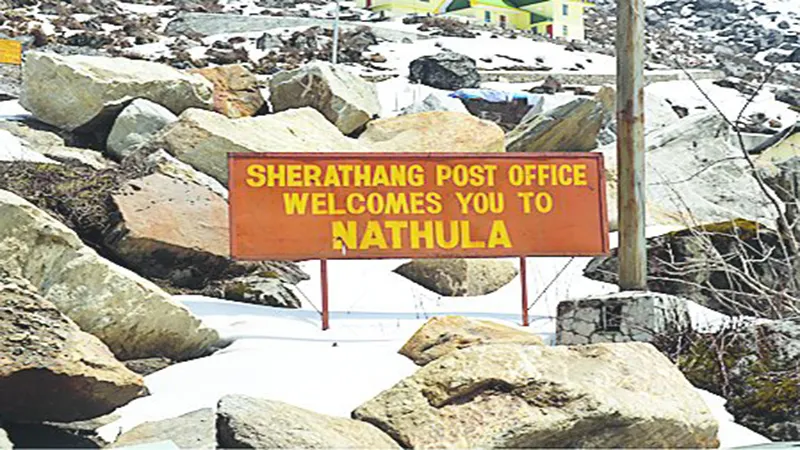The relaxing of India-China border trade norms by Prime Minister Narendra Modi, on May 2, just ahead of his visit to China has renewed interests on the Nathu La pass. The pass has already been announced as an additional route to Mansarovar yatra by the external affairs minister, Sushma Swaraj. The pilgrimage through Nathu La pass will begin on June 18. Five batches, consisting of 50 people each, will be sent through this new route. The government has also launched a website for the assistance of pilgrims. The pass that had once introduced European traders to the abundance of the South and Southeast Asia still commands a strategic role in the unfolding of bilateral dynamics between the newly installed regimes in India and China.
The distance between Gangtok, the capital of Sikkim and Nathu La, the land border between India and China is nearly 55 kilometres. There is a stark change in not only the terrain but also the socio-economic milieu of the region. The narrow winding snow-covered roads with a dwindling population leading up to Nathu La portray a change in guard from civilian to military control. A number of bill boards read, "You are under Chinese surveillance." This is in consonance with the literal meaning of the term, "Nathu", or "listening ears". Set in the serenity of the mountains, the pass seems to be closely observed. In the sporadic rainfalls of mid-May, the work of the Border Roads Organisation was in full swing as the external affairs minister, Sushma Swaraj, accompanied by the human resource development minister, Smriti Irani, will visit the place to formally open the pilgrimage through this pass soon.
About 5 kilometres ahead of the pass, there is a place called Sherathang, where the Indo-China Border Trade Mart is situated. The area seems desolated as trade has just formally opened on May 3 after six months of the winter season, although full-fledged trading is yet to start. Sherathang is the dumping centre on the Indian side, and Rinchengang is on the Chinese side. In Sikkim, the traders who travel to China's Rinchengang mention the four-lane road that leads from Nathu La to Rinchengang, compared to the deplorable road conditions on the Indian side. Situated at another 5 kilometres above Sherathang was the staircase to Nathu La pass, situated at 4310 metres (14,140 feet) connecting the Indian state of Sikkim and China's Tibet Autonomous Region. Nathu La is one of the three open trading border posts between China and India; the other two are Shipkila in Himachal Pradesh and Lipulekh (or Lipulech) in Uttarakhand. It is also one of the four officially agreed border personnel meeting points between the Indian Army and the People's Liberation Army of China for regular consultations and interactions.
The pass located at a strategic point in the Old Silk Route has been traversed by the Chinese traveller, Fa Hien, and the monk, Hiuen Tsang, in the 5th and 6th centuries, respectively. Thus, it was not just silk and goods that have been traded through this route but also culture and religion. After almost a decade of formalizing border trade (since 2006), the reactions of traders and common people to "khasa ka saman" - Chinese goods, in Gangtok popular parlance - was astonishing.
Although open for four days a week, the dumping of goods is very sporadic. The Indian traders make payments in rupees and the Chinese ones in yuan. As ATM facilities are existing in the hilly terrain, the traders express a desire to have currency exchange units right at the dumping centres to facilitate smoother transactions. The common people admit that Chinese blankets and woollens have saved them the time and energy expended on knitting them for one whole season or travelling all the way to Siliguri to buy them. But they also talk about the sub-standard quality and poor longevity. From this point of view, it may be inferred that "khasa ka saman" has a limited market penetration potential, and people tend to buy them on trial only. A sense of loss of the indigenous industries prevails among the common people as the Gangtok markets are flooded with "khasa ka saman" far out-numbering the indigenous ones. The traders and tourism sector representatives are optimistic about the opening up of the pass for pilgrimage as they believe it would fetch more goods from either side. They are also appreciative of the low cost of the registration of traders and government support. However, the unpredictable weather and the hilly terrain make seamless trade difficult.
At the close of 2014, while the total exports from India to China during the year, 2014, amounted to Rs 16,04,43,830, the total imports from China to India stood at Rs 1,02,53,400. While the exports have seen an increase of 107 per cent, the imports have decreased by 12 per cent. The major items of export from India to China are vegetable oil, rice, processed food, canned food, textiles, copper items and so on, and the major items of import from China to India include blankets, readymade garments, carpet and quilts. This is quite an exception to the steep trade imbalance that India suffers with China. India's trade deficit with China has climbed to a whopping $37.8 billion, whereas bilateral trade has stood at $65.85 billion in 2013-14.
The Chinese president, Xi Jinping, since his coronation has been popularizing the economic belt and maritime silk route initiative in a bid to expand the Chinese foot-print throughout the length and breadth of Asia. The Nathu La pass and its heightened fluidity have strategic implications for the present Indian government. This is not only because it lies at the fulcrum of China's proposed economic belt and the old silk route revival plans of India but also because it is a way of developing the Indian influence in China's soft underbelly, the Tibet Autonomous Region. Unlike in Arunachal Pradesh and Aksai Chin, where the undetermined border makes moves by either country controversial, decision-making along Nathu La leaves room for little contention from the Indian side because of unanimity on the Sikkim-Tibet border. It may be recalled that it was under the coalition led by Bharatiya Janata Party in 2003 that there was a considerable thaw in bilateral relations after the China visit of the prime minister then, Atal Bihari Vajpayee, who sealed the agreement on opening up Nathu La for trade with China. The border trade had officially started from 2006 and still continues for six months (May 13 - November 13).
The resurfacing of Nathu La in India's China policy may be an apt example of how trade and tourism resolve tensions. The growing interdependency of both the countries through the pass may lead to desecuritization and demilitarization. This may have significant implications for Siachen and other less accessible areas.
(The writers are researchers of Observer Research Foundation, Kolkata)
Courtesy: (
The Telegraph) 30 May, 2015
The views expressed above belong to the author(s). ORF research and analyses now available on Telegram! Click here to access our curated content — blogs, longforms and interviews.




 PREV
PREV


